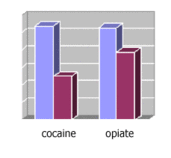Many researchers prefer to determine substance use by biological assays rather than self-report because they are relatively less prone to errors of falsification and memory distortion. This is particularly valuable for research that requires participants to report behaviors that many feel are socially undesirable, such as drug use or gambling. Some research has found no relationship between pathological gambling status and biologically evaluated drug use among cocaine-dependent patients in treatment with buprenorphine, a medication for opiate dependence (Hall et al., 2000). A recent study further explored this issue by examining problem gambling status and toxicological evidence of opiate and cocaine use among methadone maintenance patients (Ledgerwood & Downey, 2002).
Using the South Oaks Gambling Screen (Lesieur & Blume, 1987), researchers assessed the gambling pathology of 62 methadone maintenance patients. About 18% endorsed 5 or more SOGS items, the study criteria for probable pathological gambling status. During the course of their treatment, 59 of these patients submitted urine for toxicology testing. Nine of these patients endorsed 5 or more SOGS items. The other 50 patients endorsed fewer than 5 SOGS items.
Figure 1: Proportion testing positive for substance use
As Figure 1 demonstrates, relative to non-pathological gamblers, significantly more probable pathological gamblers tested positive for cocaine use (p <.05). Probable pathological gamblers also were more likely to have used opiates, but this difference was not significant.
The small sample size limits the generalizability of the study. However, the proportion of methadone patients satisfying criteria for probable pathological gambling in this study is similar to the rate of this problem in similar populations as described in other published studies (Ledgerwood & Downey, 2002). A second limitation is the self-report of gambling behavior. Although biological evidence about drug use might be safe from errors of falsification and memory distortion, self-reported gambling behavior is not. Future research needs to develop similarly valid methods of identifying gambling pathology—this need provides additional support to efforts to identify a diagnostic “gold” standard (Shaffer, Hall, & Vander Bilt, 1997; Shaffer & Korn, 2002).
The Ledgerwood & Downey study reminds us that addictions do not occur in isolation. Research on the temporal sequencing of substance use disorders (e.g. Shaffer & Eber, 2002) and gambling problems should shed light on whether some addictions cause others, whether both are related to some other factors, or whether both are symptomatic of a broader addiction syndrome.
Comments on this article can be addressed to Debi LaPlante.
References
Hall, G. W., Carriero, N. J., Takushi, R. Y., Montoya, I. D., Preston,
K. L., & Gorelick, D. A. (2000). Pathological gambling among cocaine-dependent outpatients. American Journal of Psychiatry, 157(7), 1127-1133.
Ledgerwood, D. M., & Downey, K. K. (2002). Relationship between problem gambling and substance use in a methadone maintenance population. Addictive Behaviors, 27, 483-491.
Lesieur, H. R., & Blume, S. B. (1987). The South Oaks Gambling Screen (SOGS): A new instrument for the identification of pathological gamblers. American Journal of Psychiatry, 144, 11841188.
Shaffer, H. J., & Eber, G. B. (2002). Temporal progression of cocaine dependence symptoms in the national comorbidity survey. Addiction, 97, 543-554.
Shaffer, H. J., Hall, M. N., & Vander Bilt, J. (1997). Estimating the prevalence of disordered gambling behavior in the United States and Canada: a meta-analysis. Boston: Presidents and Fellows of Harvard College.
Shaffer, H. J., & Korn, D. A. (2002). Gambling and related mental disorders: a public health analysis, Annual Review of Public Health (Vol. 23, pp. 171-212). Palo Alto: Annual Reviews, Inc.





